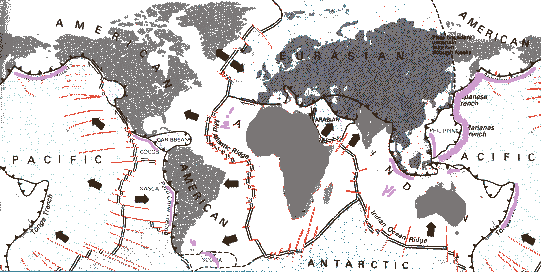Active volcanoes / Aktive vulkaner:
|
Sounds interesting? At least it did to me. And so I
began searching. Mostly on Internet, but also in my own books and encyclopedias.
The result was quite confusing.. See my page: Platetektonikk???. Well, to be honest, I first of all learned that I did
not know much at all about this thing called volcanoes and plate-tectonics.
But to get further in this story, one has to know a little more about
the theory called plate-Tectonics and its history, but have to put
that on another page, so this piece here won't be too long...... As shown on the map above, the earth is cut into several pieces, all borders consisting of either a crust or a subductionzone or what else it might show up to be. OK, so we are almost sure that those pieces are plates, and that some of them moves in certain directions, at the time being, about 2-12 centimeters ( 2-3 inches?) each year We are also sure that some of them goes down under the others, in socalled
subductionszones, But then - here comes the questions. You ought to have a subductionzone
to keep kind of balance of the earth - the radiant, or the distance
from the center of the Earth and to surface at the equator line or to
one of the two poles, has to be constant. (xxxx km at the poles). From
the spreading-zones comes up new lava, and new landmasses forms, and
the plates move away from here. Subduction zones are typically deep
trenches, where one of the plates dissapers downwards (usually the ocean-plate). But somehow there are a lot of other trenches in the big oceans where nothing is happening. Nothing dissapears, and nothing comes up. At he same time there are mountain ridges coming up both here and there the more maps you can get hold of. How or what have made them drop up? It's still a bit too difficult to understand these theories,
so I'm going to continue my study..... Put your opinions right down in
the mail-box!
|


